If things had gone a little different at Walt Disney Animation Studios back in the early 1980s, it wouldn’t have been J.K. Rowling who first introduced the world to the idea of a school that then specialized in teaching wizardry and witchcraft. But rather, it would have been another English author – Mary Stewart – who would have been credited with popularizing this concept. Thanks largely to “The Little Broomstick,” a movie that the Mouse House came within inches of making.
To explain: Back in the late 1960s, Stewart (i.e., a British novelist who mostly worked in the romantic mystery vein) wrote her first real book for children. Entitled “The Little Broomstick,” this 192-page tale detailed the adventures of 10-year-old Mary Smith. Who had been left with her Great Aunt Charlotte out in the English countryside while her parents went off on holiday to America.
Fighting boredom one afternoon, Mary follows a black cat named Tib out into the nearby forest. Once there, she comes across this weird clump of flowers as well as an old broomstick hidden in the underbrush. Mary brings all three of these items (i.e., the cat, the flowers & the broomstick) back to her great aunt’s home. Where – once these three magical items get in close proximity – they then send this 10 year-old girl rocketing through the sky.
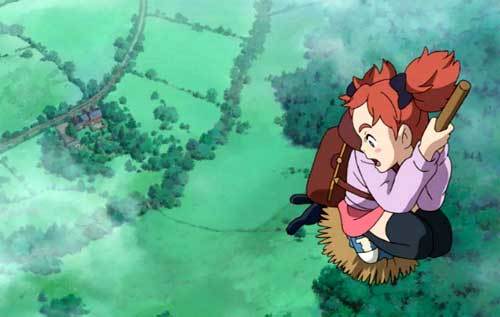
When Mary finally comes back down to earth, she finds herself at Endor College, a fantastical school for magic. The headmistress there – one Madam Mumblechook – mistakenly believes that this human girl is a prodigy when it comes to prestidigitation. Whereas Mary – as she’s being taken by Mumblechook on a tour of the campus – comes across evidence that something isn’t quite right at Endor. That transformation experiments which the school’s staff have been conducting on the local animal population have perhaps had some cruel consequences.
It was this exact mix of story elements – a young girl who suddenly finds herself in a fantastical setting dealing with all sorts of colorful characters, animals that need rescuing, magic & flying – that put “The Little Broomstick” on Disney’s radar. So just a few months after Brockhampton Press published Stewart’s story in 1971, Walt Disney Productions acquired the film rights to this book.
“The Little Broomstick” then remained in creative limbo for the better part of the next decade as Mouse House managers tried to decide what would be the very best approach to take with this material. Should Stewart’s book be adapted for the screen as a live-action project? Or would animation be a better / smarter way to go? Maybe some combination of these two techniques (which would then put “The Little Broomstick” in the exact same category as previous high-profile Disney productions like Mary Poppins, Bedknobs and Broomsticks and Pete’s Dragon)?
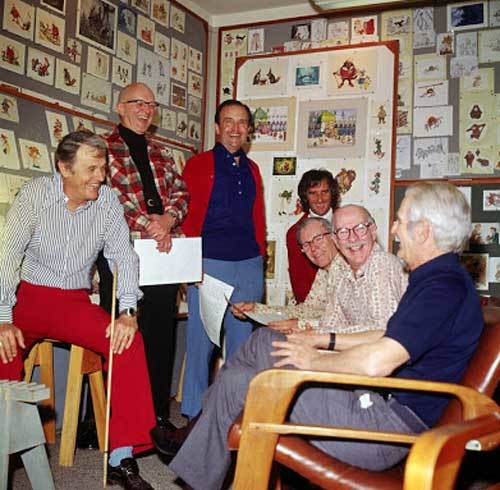
Woolie Reitherman (left side of photo — red pants) with a room full of Disney Legends working on 1973’s “Robin Hood.”
In the end, Woolie Reitherman (i.e., the Disney Legend who directed One Hundred and One Dalmatians, The Jungle Book, The Aristocats, Robin Hood, and The Rescuers for the Studio) thought that “The Little Broomstick” might be a fun project to follow The Fox and the Hound (which would eventually be released to theaters in July of 1981). So Reitherman got together with Mel Shaw, a veteran story man and visual development artist, and began working on a movie version of Stewart’s book.
Woolie & Mel spent much of 1980 trying to turn “The Little Broomstick” into proper fodder for a full length animated feature. They filled a production suite at Disney Studios floor-to-ceiling with pastel sketches pertaining to this project.
Modern animation master Andreas Deja was just getting started at Walt Disney Animation Studios (he didn’t officially get hired by the Mouse House ‘til August of 1980) when Reithermation & Shaw were working on their movie version of “The Little Broomstick.” But Andreas managed to get into that production suite where all of the development art for this proposed motion picture was on display. And as Deja recounted to me during a 2016 phone interview, “… Mel's pastel sketches for this film were incredible. The story – as Woolie pitched it to me – sounded utterly charming. I’m sure that – if the Studio had allowed production of ‘The Little Broomstick’ to go forward – Disney would have then wound up with a beautiful little animated feature.”

So – with all this going for the movie version of Mary Stewart’s book that Reitherman & Shaw wanted to make – why did Disney’s 1980 era management team opt not to greenlit production of “The Little Broomstick” ? I’ve heard a variety of explanations over the years.
Some Mouse House veterans will tell you that it was Bedknobs and Broomsticks that ultimately did in the movie version of “The Little Broomstick.” That – in the end – there were just too many similarities between the characters & settings that were featured in that 1971 live action / animated Walt Disney Productions release and the film that Woolie & Mel wanted to make. Since the Studio didn’t want to be seen as repeating itself, that’s why production of “The Little Broomstick” supposedly ultimately got tabled.
Still other studio vets will tell you that the real reason the Mouse opted not to make the movie that Reitherman & Shaw were proposing was because … Well, the early 1980s were a time of transition at Walt Disney Animation Studios. There were a number of young turks working there who then challenged the status quo. They wanted Disney to step away from making safe animated features (i.e., movies that featured talking animals or cute kids) and – instead – do something daring. Something ambitious.
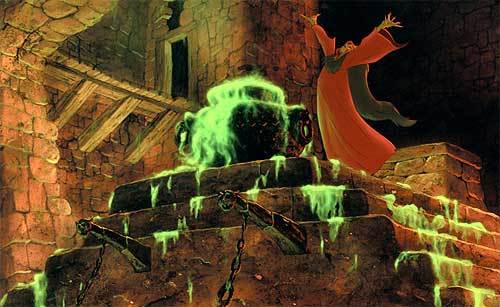
In the end, it was this faction at Walt Disney Animation Studios that won out. So – instead of producing an animated version of Mary Stewart’s single book for children – those young turks then tried to turn Lloyd Alexander’s five book series, “The Chronicles of Prydain,” into this generation’s Fantasia or Snow White and the Seven Dwarfs.
The end result of this project was The Black Cauldron, the first Walt Disney Animation Studios to ever receive a PG rating. This July 1985 release did so poorly at the box office that – for a time – the Company’s then-newly installed management team (i.e., Michael Eisner, Frank Wells, and Jeffrey Katzenberg) actually toyed with shutting down the Mouse Factory. It was only the timely intervention of Roy E. Disney (i.e., the nephew of the company’s founder) that kept this Studio in the feature animation business.
As for “The Little Broomstick” … When Disney’s movie rights for this Mary Stewart book finally lapsed, they then reverted back to Brockhampton Press’ parent company, the Hachette Children’s Group (HCG).
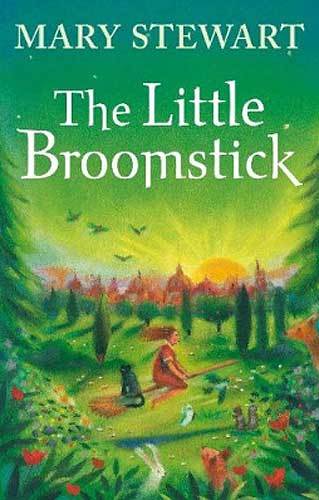
Now jump ahead to 2015. Which was when former Ghibli film director Hiromasa Yonebayashi (The Secret World of Arrietty and When Marnie Was There) and producer Yoshiaki Nishimura (The Tale of the Princess Kaguya) founded Studio Ponoc with the help of several former Studio Ghibli animators.
This talented group was looking for a book to build Studio Ponoc’s first full-length animated feature around. Given that Yonebayashi had previously had some success with stories that British children’s authors had written (EX: The Secret World of Arrietty was based on “The Borrowers.” Which Mary Norton wrote. FYI: Norton also wrote “The Magic Bedknob” and “Bonfires and Broomsticks,” which Walt Disney Productions then used as the inspiration for its Academy Award-winning December 1971 release, Bedknobs and Broomsticks), he began looking at similar titles. Which is when Hiromasa came across Mary Stewart’s “The Little Broomstick.”
To Yonebayashi’s way of thinking, what made “The Little Broomstick” perfect as Studio Ponoc’s debut project is that – while it had some similarities with one of Studio Ghibli’s earliest successes (i.e., 1989’s Kiki’s Delivery Service) – it was also its own story. Which is why – in December of 2016 – Hiromasa cut a deal with the Hachette Children’s Group to acquire the film rights to this Mary Stewart book.
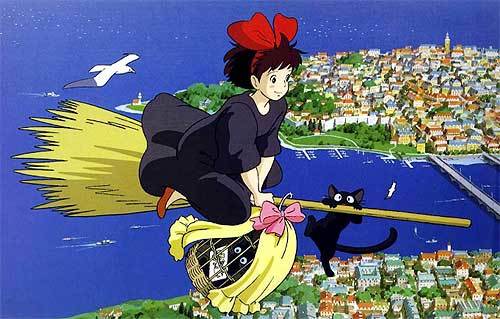
So what would Woolie Reitherman & Mel Shaw have made of Mary and the Witch’s Flower (which opened in Japanese cinemas this past summer but – thanks to Fathom Events – is debuted in North American theaters tomorrow in a special one-night-only premiere event)? I’d have to imagine that these two Disney Legends would be very pleased with what Studio Ponoc has achieved here. Given that Nishimura & Co. managed to turn “The Little Broomstick” into a true showcase for traditional animation. You know? The sorts of movies that the Mouse Factory used to make?
